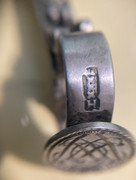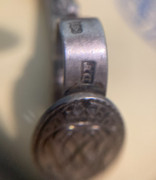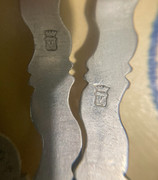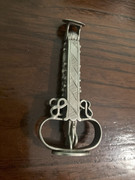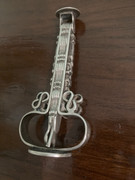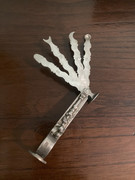Hi Peter,
Thanks once more for your additional comments, that as often bring an interesting light on this silver item.
(thanks also for the link and the translation from Dutch !)
Now that you outlined that this is a pipe set, it appears clearer for me. I personaly do not smoke, and since pipe is quite old-fashioned now, it is quite a long time since I last saw a pipe-smoker, with its small set that they use in order to set or "arrange" its tobacco in the pipe : I thus did not make the link till you did.
The silversmith idea/conception of an item that joins a (double) seal with a pipe set nevertheless appears a bit strange to me, since I do not see a clear link between these two types of item (except, to some extend, that both a seal and a pipe set can be considered as : small, and quite "personnal" item).
The general design of my seal & pipe set is indeed very close to the one of the item APM 4.647 made in Haarlem, "1725-65" and from the Amsterdam pipe museum shown on your link -even if one of the four (or five, with the small seal) moving tools differ from one item to the other (a rong tool for tamping tobacco Vs a tool with two crescent tips).
Datation of the item APM 4.647 provided by the museum notice is a bit imprecise "Haarlem, 1725-65" :
https://pipemuseum.nl/nl/collection/apm-4-647
based on the picture of the marks provided with the notice, would it be possible to be more precise ?
